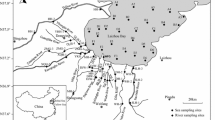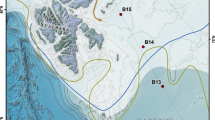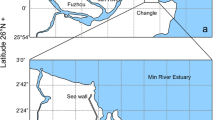Abstract
Analysis of 3-m sediment cores revealed that profiles of carbon (C), sulfur (S), and iron (Fe) varied with relative distance from marine and terrestrial sediment sources in Tomales Bay California. Despite relatively high sedimentation rates throughout the bay (historically 3–30 mm yr−1), sulfate reduction of deposited organic matter led to free-sulfide accumulation in sediments only at the location farthest from terrestrial runoff, the source of reactive iron. Acid-volatile sulfide concentrations in all sediments (<10 μmol g−1) were low relative to concentrations of chromiumreducible sulfide (up to 400 μmol g−1 farthest from the reactive iron source). A calculated index of iron availability, used to describe sediment resistance to build-up of free sulfide, was lowest at this location. Recent, upward shifts in reactive Fe concentration and in the relative contribution of terrestrial orgnic carbon (measured as a shift in δ13C of bulk sediment organic matter) in all cores indicated that erosion and transport of sediments from the watershed surrounding Tomales Bay increased after European settlement in the 1850s.
Similar content being viewed by others
Literature Cited
Aller, R. C., J. E. Mackin, andR. T. Cox, Jr. 1986. Diagenesis of Fe and S in Amazon inner shelf muds; apparent dominance of Fe reduction and implications for the genesis of ironstones.Continental, Shelf Research 6:263–289.
Anschutz, P., S. Zhong, B. Sundby, A. Mucci, andC. Gobeil. 1998. Burial efficiency of phosphorus and the geochemistry of iron in continental margin sediments.Limnology, and Oceanography 43:53–64.
Bein, A., A. Aumogi-Labin, andE. Sass. 1990. Sulfur sinks and organic carbon relationships in Cretaceous organic-rich carbonates: Implications for evaluation of oxygen-poor depositional environments.American Journal of Science 290:882–911.
Berner, R. A. 1970. Sedimentary pyrite formation.American Journal of Science 268:1–23.
Bird, M. I., R. E. Summons, M. K. Gagan, Z. Rorsandic, L. Dowling, J. Head, L. K. Fieield, R. G. Cresswell, andD. P. Johnson. 1995. Terrestrial vegetation change inferred from n-alkane d13C analysis in the marine environment.Geochimica et Cosmochimica Acta 59:2853–2857.
Boesen, C. andD. Postma. 1988. Pyrite formation in anoxic environments of the Baltic Sea.American Journal of Science 288: 575–603.
Boudreau, B. P. 1994. Is burial velocity a master parameter for bioturbation?Geochimica et Cosmochimica Acta 58:1243–1249
Brandes, J. A. andA. H. Devol. 1997. Isotopic fractionation of O2 and N2 in coastal marine sediments.Geochimica et Cosmochinica Acta 61:1793–1801.
Canfield, D. E. 1989a. Sulfate reduction and oxic respiration in marine sediments: Implications for organic carbon preservation in euxinic sediments.Deep-Sea Research 36:121–138.
Canfield, D. E.. 1989b. Reactive iron in marine sediments.Geochimica et Cosmochimica Acta 53:619–632.
Canfield, D. E. andR. A. Berner. 1987. Dissolution and pyritization of magnetite in anoxic marine sediments.Geochimica et Cosmochinica Acta 51:645–659.
Canfield, D. E., B. B. Jørgense, H. Fossing, R. Glud, J. Gundersen, N. B. Ramsing, B. Thamdrup, J. W. Hansen., L. P. Nielsen, andP. O. J. Hall. 1993. Pathways of organic carbon oxidation in three continental margin sediments.Marine Geology 113:27–40.
Canfield, D. E., R. Raiswell, andS. Bottrell. 1992. The reactivity of sedimentary iron minerals toward sulfide.American Journal of Science 292:659–683.
Chambers, R. M., J. T. Hollibaugh, andS. M. Vink. 1994. Sulfate reduction and sediment metabolism in Tomales Bay, California.Biogeochemistry 25:1–18.
Chanton, J. P., C. S. Martens, andM. B. Goldhaber. 1987. Biogeochemical cycling in an organic-rich coastal marine basin. 7. Sulfur mass balance, oxygen uptake and sulfide retention.Geochimica et Cosmochimica Acta 51:1187–1199.
Cline, J. D. 1969. Spectrophotometric determination of hydrogen sulfide in natural waters.Limnology and Oceanography 14: 454–459.
Conley, D. J., C. L. Schelske, andE. F. Stoermer. 1993. Modification of the biogeochemical cycle of silica with eutrophication.Marine Ecology Progress Series 101:179–192.
Cornwell, J. C. andP. A. Sampou. 1995. Environmental controls on iron sulfide mineral formation in a coastal plain estuary, p. 224–242.In M. A. Vairavamurthy and M. A. A. Schoonen (eds.), Geochemical Transformations of Sedimentary Sulfur. American Chemical Society, Washington, D.C.
Edenborn, H. M., N. Silverberg, A. Mucci, andB. Sundby. 1987. Sulfate reduction in deep coastal marine sediments.Marine Chemistry 21:329–345.
Fallon, R. D. 1987. Sedimentary sulfides in the nearshore Georgia Bight.Estuarine, Coastal and Shelf Science 25:607–619.
Fossing, H. andB. B. Jørgensen. 1989. Measurement of bacterial sulfate reduction in sediments: Evaluation of a singlestep chromium reduction method.Biogeochemistry 8:205–222.
Gagnon, C., A. Mucci, andE. Pelletier. 1995. Anomalous accumulation of acid-volatile sulphides (AVS) in a coastal marine sediemnt, Saguenay Fjord, Canada.Geochimica et Cosmochimica Acta 59:2663–2675.
Giblin, A. E., K. H. Foreman, andG. T. Banta. 1995. Biogeochemical processes and marine benthic community structure: Which follows which? p. 37–44.In C. G. Jones and J. H. Lawton (eds.) Linking Species and Ecosystems. Chapman and Hall, New York.
Goldhaber, M. B. andI. R. Kaplan. 1975. Controls and consequences of sulfate reduction rates in recent marine sediments.Soil Science 119:42–55.
Haese, R. R., K. Wallmann, A. Dahmke, U. Kretzmann, P. J. Muller, andH. D. Schulz. 1997. Iron species determination to investigate early diagenetic reactivity in marine sediments.Geochimica et Cosmochinica Acta 61:63–72.
Hedges, J. I. andA. Van Green. 1982. A comparison of lignin and stable carbon isotopic compositions in Quaternary marine sediments,Marine Chemistry 11:43–54.
Hines, M. E., D. A. Bazylinski, J. B. Tugel, andW. B. Lyons. 1991. Anaerobic microbial biogeochemistry in sediments from two basins in the Gulf of Maine. Evidence for iron and manganese reduction.Estuarine, Coastal and Shelf Science 33: 312–324.
Howarth, R. W., J. R. Fruci, andD. Sherman. 1991. Inputs of sediment and carbon to an estuarine ecosystem: Influence of land use.Ecological Applications 1:27–39.
Ittekkot, V. 1988. Global trends in the nature of organic matter in river suspensions.Nature 232:436–438.
Jordan, T. E., D. L. Correll, J. Miklas, andD. E. Weller. 1991. Long-term trends in estuarine nutrients and chlorophyll, and short-term effects of variation in watershed discharge.Marine Ecology Progress Series 75:121–132.
Jørgensen, B. B. 1978. A comparison of methods for the quantification of bacterial sulfate reduction in coastal marine sediments I. Measurement with radiotracer technique.Geomicrobiology Journal 1:11–27.
Jørgensen, B. B., M. Bang, andT. H. Blackburn. 1990. Anaerobic mineralization in marine sediments from the Baltic Sea-North Sea transition.Marine Ecology Progress Series 59:39–54.
Joye, S. B. andJ. T. Hollibaugh. 1995. Influence of sulfide inhibition of nitrification on nitrogen regeneration in sediments.Sciene 270:623–625.
Kostka, J. E. andG. W. Luther, III. 1995. Seasonal cycling of iron in saltmarsh sediments.Biogeochemistry 29:159–181.
Leventhal, J. S. 1983. An interpretation of carbon and sulfur relationships in Black Sea sediments as indicators of environments of deposition.Geochimica et Cosmochinica Acta 47:133–137.
Morse, J. W. andJ. C. Cornwell. 1987. Analysis and distribution of iron sulfide minerals in recent anoxic marine sediments.Marine Chemistry 22:55–69.
Morse, J. W., J. C. Cornwell, T. Arakaki, S. Lin, andM. Huerta-Diaz. 1992. Iron sulfide and carbonate mineral diagenesis in Baffin Bay, Texas.Journal of Sedimentary Petrology 62:671–680
Morse, J. W. andK. C. Emeis. 1990. Controls on C/S ratios in hemipelagic upwelling sediments.American Journal of Science 290:1117–1135.
Plant, J. N. 1995. Effects of land use change on Tomales Bay, California: New ideas from old tracers. Master's Thesis, University of Hawaii, Honolulu, Hawaii.
Raiswell, R., D. E. Canfield, andR. A. Berner. 1994. A comparison of iron extraction methods for the determination of DOP and the recognition of iron-limited pyrite formation.Chemical Geology 111:101–110.
Reeburgh, W. S. 1967. An improved interstitial water sample.Limnology and Oceanography 12:163–165.
Reeburgh, W. S. 1980. Anaerobic methane oxidation: Rate depth measurements in Skan Bay sediments.Earth and Planetary Science Letters 47:345–352.
Rooney, J. 1995. Determination of sedimentation rate in Tomales Bay, California, using a geographic information system. Master's Thesis, University of Hawaii, Honolulu, Hawaii.
Sansone, F. J., J. T. Hollibaugh, S. M. Vink, R. M. Chambers, S. B. Joye, andB. N. Popp. 1994. Diver-operated piston corer for nearshore use.Estuaries 17:716–720.
Skyring, G. W. 1987. Sulfate reduction in coastal ecosystems.Geomicrobiology Journal 5:295–374.
Smith, S. V. andJ. T. Hollibaugh. 1997. Annual cycle and interannual variability of ecosystem metabolism in a temperate climate embayment.Ecological Monographs 67:509–533.
Smith, S. V., J. T. Hollibaugh, S. J. Dollar, andS. Vink. 1991. Tomales Bay metabolism: C-N-P stoichiometry and ecosystem heterotrophy at the land-sea interface,Estuarine, Coastal and Shelf Science 33:223–257.
Smith, S. V., W. J. Wiebe, J. T. Hollibaugh, S. J. Dollar, S. W. Hager, B. E. Cole, G. W. Tribble, andP. A. Wheeler. 1987. Stoichiometry of C, N, P and Si fluxes in a temperate-climate embayment.Journal of Marine Research 45:427–460.
Sørensen J. andB. B. Jørgensen. 1987. Early diagenesis in sediments from Danish coastal waters: Microbial activity and Mn−Fe−S geochemistry.Geochimica et Cosmochinica Acta 51:1583–1590.
Stookey, L. L. 1970. Ferrozine— A new spectrophotometric reagent for iron.Analytical Chemistry 42:779–781.
Thamdrup, B. andD. E. Canfield. 1996. Pathways of carbon oxidation in continental margin sediments off central Chile.Limnology and Oceanography 41:1629–1650.
Thamdrup, B., H. Fossing, andB. B. Jørgensen. 1994. Manganese, iron and sulfur cycling in a coastal marine sediment, Aarhus Bay, Denmark.Geochimica et Cosmochimica Acta 58: 5115–5129.
Source of Unpublished Materials
Sansone, F. J. personal communication. Department of Oceanography, University of Hawaii, Honolulu, Hawaii 96822
Author information
Authors and Affiliations
Corresponding author
Rights and permissions
About this article
Cite this article
Chambers, R.M., Hollibaugh, J., Snively, C.S. et al. Iron, sulfur, and carbon diagenesis in sediments of Tomales Bay, California. Estuaries 23, 1–9 (2000). https://doi.org/10.2307/1353220
Received:
Accepted:
Issue Date:
DOI: https://doi.org/10.2307/1353220




